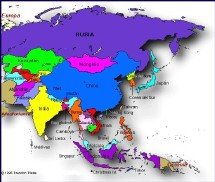Will American Global Dominance End In 2020?
Culture rather than technology will determine which countries will have the cutting edge. Manufacturing will no longer be the key to economic success. China will become the world's largest economy. The US must overcome its law-and-order problems to survive. Japan's rise will peak. The environment, the role of government, technology and natural resources, as well as the costs of social disintegration, will contribute to this new competitive landscape. The likely emergence of China and India as new major global players—similar to the advent of a united Germany in the 19th century and a powerful United States in the early 20th century, will transform the geopolitical landscape with impacts potentially as dramatic as those in the previous two centuries. India and China will increasingly flex powerful political and economic muscles as major new global players by 2020, an in-house CIA think tank has said, likening the rise of the two countries to the emergence of the United States as a world power, a century ago.  Read more ... *US position will erode, conclude CIA planners *India, China Global Players by 2020:CIA The two nuclear-armed Asian giants—one a vibrant democracy, the other a one-party state—will ‘‘transform the geopolitical landscape’’ because of their robust economic growth, expanding military capabilities and large populations, the National Intelligence Council (NIC) predicted. The United States will remain "an important shaper of the international order, "probably the single most powerful country, but its "relative power position" will have "eroded." The new "arriviste powers," not only China and India, but also Brazil, Indonesia, and perhaps others, will accelerate this erosion by pursuing "strategies designed to exclude or isolate the United States" in order to "force or cajole" us into playing by their rules.  India and China soon plans to form a trade coalition in Asia and that is projected to boast 65% of world trade by tear 2020. Both the countries India and China are determined to achieve that and create a huge impact on world economic bodies. - Economic growth is expected to remain robust over the next 15 years with the United States, China and India accounting for more than 50 percent of all new growth. Overall, global gross domestic product (GDP) will grow at an annualized rate of 3.5 percent. - The US, which will account for 16 percent of the world's economic growth, will continue to outpace other major developed economies between now and 2020. U.S. growth will be driven by its ability to continue to add knowledge workers to its workforce that are strong in skills such as collaboration, communication, decision-making and leadership. In addition, the US will benefit from interaction-based productivity from continued investment and use of information technologies. - By 2020, China's economy measured at purchasing power parity (PPP) exchange rates will be on par with the United States and Asia's overall share of the global economy will rise to 43 percent from 35 percent currently. During this growth period, China is set to have the second largest consumer market and will have the largest tech sector. Read more ... *U.S., China and India Growth to Expand World Economy to $100 Trillion by 2020 *India and China can control 65% of world trade by 2020 *India, China will be economic giants *Report foresees gains by China,India *THE WORLD IN 2020 America's current foreign policy is encouraging this trend, the NIC (National Intelligence Council) concluded, "U.S. preoccupation with the war on terrorism is largely irrelevant to the security concerns of most Asians." A "key question" for the future of America's power and influence is whether U.S. policy-makers "can offer Asian states an appealing vision of regional security and order that will rival and perhaps exceed that offered by China." If not, "U.S. disengagement from what matters to U.S. Asian allies would increase the likelihood that they will climb on Beijing's bandwagon and allow China to create its own regional security that excludes the United States."  To the extent that these new powers seek others to emulate, they may look to the European Union, not the United States, as "a model of global and regional governance." Not a day goes by without another story about how we're mortgaging our future to the central banks of China and Japan. The U.S. budget deficit, approaching a half-trillion dollars, is financed by their purchase of Treasury notes. The U.S. trade deficit, much of it amassed by the purchase of Chinese-made goods, now exceeds $3 trillion. Meanwhile, China is displacing the United States all across Asia, in trade, investment, education, culture, and tourism. It's also cutting into the trade markets of Latin America.  World Energy Consumption Today Country % of Energy Consumed % of World Population United States 25% - 4.6% China 9.9% - 21.2% Russia 7.0% - 2.5% Japan 5.8% - 2.1% Germany 3.9% - 1.3% India 3.1% - 16.6% France 2.9% - .9% U.K. 2.6 % - 1% Canada 2.5% - .5% Korea 1.9 % - .7% The United States, with 5% of the world's population, daily consumes 20.5 million barrels (862 million gallons) - - or 26% of world consumption. U.S. consumption is at a record high while U.S. oil production is at a 50-year low and declining, covering just 30% of our consumption needs - - a 70% gap, and reserves are declining. Read more ... *USA Energy Consumption  Energy Sources Natural gas is projected to be the fastest growing primary energy source worldwide, maintaining growth of 3.2 percent annually over the 1999-2020 period, more than twice as high as the rate for coal. Natural gas consumption is projected to rise from 84 trillion cubic feet to 162 trillion cubic feet in 2020, primarily for electricity generation.  Gas is increasingly seen as the desired alternative for electric power, given the efficiency of combined-cycle gas turbines relative to coal- or oil-fired generation, and because it burns more cleanly than either coal or oil, making it a more attractive choice for countries interested in reducing greenhouse gas emissions. Coal use worldwide is projected to increase by 1.7 billion short tons (36 percent) between 1999 and 2020. Substantial declines in coal use are projected for Western Europe and the EE/FSU countries where natural gas is increasingly being used to replace coal, to fuel new growth in electric power generation, and for other industrial and building sector uses . In the developing world, however, even larger increases in coal use are expected. The largest increases are projected for China and India, where coal supplies are plentiful. Together these two countries account for more than 90 percent of the projected rise in coal use in the developing world over.  Read more ... *World Energy Consumption * Mainland China has nine nuclear power reactors in operation and a further two units under construction. Additional reactors are planned, to give a fivefold increase in nuclear capacity to 40 GWe by 2020. * The country aims to become self-sufficient in reactor design and construction, as well as other aspects of the fuel cycle. * Electricity demand is growing very rapidly. * Mainland China is starting to rely heavily on imported uranium to fuel its nuclear power program. * On Taiwan six nuclear power reactors operate and two advanced reactors are under construction.  Peak Oil World crude oil production will peak in 2020 at 90 million barrels per day. He forecasts that U.S. crude oil production will cease by about 2090 and world production will be nearly exhausted by the year 2100. "Our children and grandchildren are going to be mad at us for burning all this oil," because oil can be put to more valuable use in producing petrochemicals and pharmaceuticals such as plastics, fertilizers, herbicides and medicines, he said. "It took the Earth 500 million years to create the stuff we're burning in 200 years," As the dollar's rate of return declines, currency investors—including those who have been financing our deficit, begin to diversify their holdings. In China, Japan, Russia, and the Middle East, central bankers have been unloading dollars in favor of euros. The Bush policies that have deepened our debt have endangered the dollar's status as the world's reserve currency.  References ... *THE WORLD OF 2020 AND ALTERNATIVE FUTURES *The balance of power:energy in 2020 *Audio:Even drug dealers are giving up on the dollar Middle East Today, the 22 Arab countries have a population of approximately 280 million people. But within two decades, this is likely to grow to approximately 450 million. Today, 38% of its population is below 14 years of age. And while the population of Arab countries is exploding, their economies are stagnating. During the last two decades, the Arab world has had the weakest economic development of any region in the world — with the exception of sub-Saharan Africa. Read more ... *...the Third Wave of Globalization  al-Qaeda's Long-term Plan Consistent with the thinking attributed to the radical Islamic leaders surrounding him, and the stages of action he lays out are consistent with their strategic game plan, which includes seven stages leading to the ultimate victory of Islam over the West in 2020. These stages are ... (1) The “awakening,” which refers to the attacks of 9/11, designed to make the Islamic movement a central player on the global scene. (2) “opening the eyes,” the period from 2003 to 2006 that will transform al-Qaeda into a “mass movement;. (3) “arising and standing up,” the period from 2007 to 2010 that will focus on terrorist destabilization of existing Muslim regimes. (4) the toppling of the moderate regimes of Egypt, Jordan, Turkey and other Muslim states from 2010 to 2013. (5) the formation of a new world order between 2013 and 2016, based on an Islamic Caliphate as a world power and the weakening of the United States and Israel. (6) a total confrontation between Islam and the West in 2016-2020. (7) a “Decisive Victory” for Islam in 2020. Read more ... *the Strategy of al-Qaeda  The Big Picture Destabilization of Afghanistan and the entire region fits handily in al Qaeda's long term objectives. In a thorough-going essay published in Intervention Magazine* entitled, "According To Plan -- But Whose Plan?." Stephen Morgan, looking at the bigger picture, asks "are U.S. troops close to winning the war or is al Qaeda about to release a devastating death trap?" Morgan, author of "The Mind of a Terrorist Fundamentalist," is a former executive member of the British Labour Party National Executive Committee and currently a political and management consultant based in Brussels, Belgium. He fears that the US and its allies may be "overestimating" its successes in the one-year old battle against terrorism. Read more ... *The making of an American quagmire The world economy will change, from commodity-based capitalism to intellectual capitalism. Nations relying solely on commodities will find their economies slowly shrinking: commodity prices on average have dropped continuously for the past 150 years. Nations investing in intellectual capitalism (e.g. common sense and pattern recognition) will be wealthy. Read more ... *The world of 2020 and beyond  Labels: Armageddon, Bible Prophecy, Bush Brotherhood of Death  Stumble It! Stumble It! |

















































Comments on "Will American Global Dominance End In 2020?"
post a comment